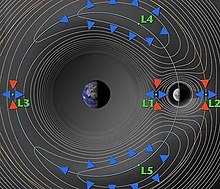Nubes de Kordylewski
Las nubes de Kordylewski (KDC) son concentraciones de polvo interesterar en los puntos de Lagrange L4 y L5 del sistema Tierra-Luna. Fueron observadas por el astrónomo polaco Kazimierz Kordylewski en los años 1960 cerca del punto de Lagrange L5. Durante mucho tiempo hubo controversia de su existencia debido a su luz muy tenue y dificultad de observación, pero en 2018 astrónomos húngaros la confirmaron con la observación de la luz polarizada linealmente reflejada en estas nubes.[1][2][3][4][5]

Kordylewski vio en octubre de 1956, una luz de un tamaño angular aproximado de 2° y tan luminoso como el Gegenschein.[6] Las fotografió en 1961 cuando parecían cambiar de tamaño y forma.[7] En 1967 J. Wesley Simpson hizo observaciones con el Observatorio Kuiper Aerotransportado.[8]
Con un tamaño angular de 2°, visto desde la Tierra, significa que podrían tener unos 72 000 km.
Véase también
editarReferencias
editar- ↑ «Celestial mechanics and polarization optics of the Kordylewski dust cloud in the Earth–Moon Lagrange point L5 – I».
- ↑ «Celestial mechanics and polarization optics of the Kordylewski dust cloud in the Earth–Moon Lagrange point L5 – II».
- ↑ «Science confirms: Earth has more than one 'moon'».
- ↑ «Observan las nubes de Kordylewski en el punto de Lagrange L5 del sistema Tierra-Luna».
- ↑ «Earth has two extra, hidden 'moons'».
- ↑ Laufer, Rene; Wilfried Tost; Oliver Zeile; Ralf Srama; Hans-Peter Roeser (February 2007). The Kordylewsky Clouds — an Example for a Cruise Phase Observation During the Lunar Mission BW1. 11th ISU Annual International Symposium. Strasbourg. Consultado el 28 de octubre de 2018.
- ↑ Kordylewski, Kazimierz (1961). «Photographische Untersuchungen des Librationspunktes im System Erde-Mond» [Photographic investigations of the libration point L5 in the Earth-Moon system]. Acta Astronomica (en alemán) 11 (3): 165-169. Bibcode:1961AcA....11..165K.
- ↑ Simpson, 1967.